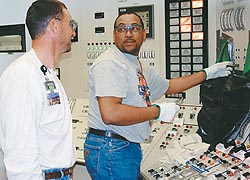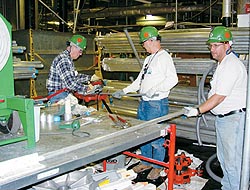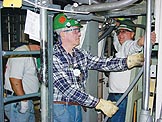TVA’s Browns Ferry Rebuilding Project
Could Signal Revival of Industry
May 2005 IBEW Journal
Belinda Phillips would like it if every citizen who is concerned about the security of nuclear power plants could shadow her for a day.
Phillips, a 16-year journey-level electrician in IBEW Local 558, Sheffield, Alabama, works at the Tennessee Valley Authority’s (TVA) Browns Ferry nuclear power plant near Athens, Alabama. She would pilot a guest through a course consisting of an explosives detector, a metal detector and an X-ray machine. Then she would have to pause to swipe her magnetic identification badge and pass her palm over a hand geometry device to confirm her identity to open a locked turnstile. Before entering
certain areas of the plant, she would have to swipe her badge again for entry.
This is only one part of the many actions the nuclear industry takes to implement its core responsibilities of ensuring safe operations and strong security. All these steps are evident at Browns Ferry, where more than 1,300 building trades workers are on site to return to service for full commercial operation, the first nuclear generation of the 21st century.
 Preparing to make repairs to a panel of the Browns Ferry Unit 2 control room are Local 558 Journeymen Wiremen Phillip Lovett, left, and Kendrick Williams. IBEW supports not only the return to service work for Browns Ferry Unit 1, but also the maintenance and modifications required for Browns Ferry’s operating units. Preparing to make repairs to a panel of the Browns Ferry Unit 2 control room are Local 558 Journeymen Wiremen Phillip Lovett, left, and Kendrick Williams. IBEW supports not only the return to service work for Browns Ferry Unit 1, but also the maintenance and modifications required for Browns Ferry’s operating units.
The Browns Ferry return to service effort highlights the importance of the TVA, created in 1933. The project is cited as one of the prime achievements of President Franklin Roosevelt’s New Deal, an example of how a governmental corporation can best serve our country.
In its earliest days, the TVA put hundreds of thousands of people in Tennessee, Mississippi, Virginia, Georgia, Alabama, Kentucky and North Carolina to work building dams and power plants, spreading economic opportunity over the region. The reduction of rural poverty initiated by electrification made the TVA remarkable. The authority’s programs to establish successful flood control, improve navigation of the river, conserve soils and reforest the Tennessee River Basin broadened the authority’s impact.
During World War II, TVA was called upon to meet demand for additional power to fuel aluminum plants for building armaments and planes. At one point, twelve hydroelectric plants and a steam plant were simultaneously under construction.
In 1959, during the Eisenhower administration, Congress—after a long and partisan debate—passed legislation to make the TVA power system self-financing. The system continued to thrive into the 1960s, producing electricity at a lower rate than most of the nation’s utilities. The TVA’s turn to nuclear power was designed to continue the cost benefits to consumers.
With the rebuild of Browns Ferry, the TVA is continuing to fulfill its mission and could help lead the way to a new era for nuclear power.
Safety is the name of the game as the trades aim for a 2007 completion date for restarting TVA’s Browns Ferry Unit 1, part of a three-reactor plant that TVA voluntarily took out of service in 1985 to fix management and operational issues. TVA restarted the Unit 2 reactor in 1991 and the Unit 3 reactor in 1995. TVA’s board of directors decided in May 2002 to do similar work to restart the Unit 1 reactor.
Between 330 and 350 IBEW members from 32 different locals are working throughout Unit 1—in the drywell, the reactor building, and the control and turbine buildings to replace or refurbish equipment. An important decision in the restart effort was to replace most of the existing cable, cable tray, and conduits in Unit 1. This decision improved production time and ensured the qualification of the material. By the end of the $1.8 billion job, IBEW members will have pulled one million feet of cable, installed 18,000 supports for 150,000 feet of conduit they installed and completed 75,000 to 100,000 terminations.
 From left to right are Raymond Richey, Local 558, Sheffield, Alabama, John Wilson, Local 606, Orlando, Florida, and Shawn Jacobs, of Local 505, Mobile, Alabama, cutting and bending conduit in preparation for installing it in the Unit 1 reactor building at Browns Ferry Nuclear Plant. From left to right are Raymond Richey, Local 558, Sheffield, Alabama, John Wilson, Local 606, Orlando, Florida, and Shawn Jacobs, of Local 505, Mobile, Alabama, cutting and bending conduit in preparation for installing it in the Unit 1 reactor building at Browns Ferry Nuclear Plant.
Robin Crafton, Tennessee Valley Trades and Labor Council (TVTLC) site representative for the project and member of Local 558, described the drywell as a large building shaped like a light bulb with concrete walls three to four feet thick and a substantial steel liner. It’s the building that houses the reactor. The drywell building is inside yet another concrete and steel building called the reactor building. Connected to the reactor building is the turbine building that holds the turbines and generators that make electricity, and between the turbine and reactor buildings is the control building where licensed reactor operators maintain and control all the plant’s functions. During operation, fuel rods inside the reactor boil water to produce steam to turn turbines that turn a generator that produces electricity.
When Unit 1 is restarted it will provide an additional 1,280 megawatts of electricity to the TVA service area—enough electricity to power more than 650,000 Tennessee Valley homes.
Like Phillips, Crafton emphasizes the extreme security measures taken at Browns Ferry to ensure public safety and the safety of the people who work there.
"My wife asked me what security is like here," he says. "I told her to think of a maximum security military installation." In fact, many of the same regulations used to protect significant military bases apply to the nation’s commercial nuclear plants. Crafton describes the electronic surveillance equipment and physical barriers that surround Browns Ferry and the rigorous inspections of personnel, packages, and vehicles that take place when entering or leaving the plant’s "protected area."
The Browns Ferry restart is governed by a project maintenance and modification agreement, signed by the presidents of building trades unions. Bechtel Power Corp. engineers the project; the general contractor is Stone and Webster Inc. Crafton, who coordinates with 15 different crafts, says, "Cooperation between them is excellent."
"This project is about safely supplying more megawatts of reliable power to customers in our area," says TVA’s Unit 1 Maintenance and Modifications Manager Rick Drake. He praises members of the TVTLC for a superb safety record on the project that is on budget and on time. In the last fiscal year, says Drake, there were only three reportable injuries, despite 1.8 million man-hours of work. TVA recently recognized Stone and Webster with an award for safe performance.
The IBEW’s performance at Browns Ferry has been enhanced by the union’s Code of Excellence program. The code is a written commitment demonstrating to customers that IBEW members perform the highest quality of work, utilize their skills and abilities to the maximum and exercise safe and productive work practices. In March 2005, International Vice President Bobby Klein rolled out the program to all Tenth District local unions.
Since that introduction, Vice President Klein and Local 558 Business Manager Larry Farmer designated Browns Ferry Unit 1, a Code of Excellence job. "Excellence Steward Training" was given to all stewards and supervisors.
Jon Rupert, TVA’s vice president for Unit 1 restart, says that electrical crews are a vital part of the large, complex, and well-planned restart effort. He says, "In addition to all the work done to restart units 2 and 3, every modification that was completed on Unit 3 since it restarted in 1995 and all the modifications that are planned for Units 2 and 3 until 2007 will be incorporated into the Unit 1 restart."
When complete, all three units at Browns Ferry will be operationally the same. Because the work done on Browns Ferry 1 is the same that was done on the other two units, when Browns Ferry 1 is safely and successfully restarted, TVA and the crafts doing the work will have shown that the industry is capable of developing a cost and schedule for a nuclear project, then delivering it on time and on budget.
 Public opinion began questioning the safety of nuclear power with the accident at Three Mile Island in 1979. A fire at Browns Ferry in 1975 also brought attention to nuclear safety, and following the Browns Ferry fire, the Nuclear Regulatory Commission enacted new safety requirements for nuclear facilities throughout the U.S. Public opinion began questioning the safety of nuclear power with the accident at Three Mile Island in 1979. A fire at Browns Ferry in 1975 also brought attention to nuclear safety, and following the Browns Ferry fire, the Nuclear Regulatory Commission enacted new safety requirements for nuclear facilities throughout the U.S.
The licensed reactor operators and the unlicensed auxiliary unit operators who operate two Browns Ferry reactors are members of IBEW Local 765 and Local 558. Like TVA’s other nuclear facilities—Sequoyah, outside Chattanooga, Tennessee, with operators from IBEW Local 721, and Watts Bar, in Spring City, Tennessee, with operators from IBEW Local 1323—Browns Ferry has won awards for achieving high performance and safety standards.
International Representative Todd Newkirk of the IBEW Utility Department said: "Browns Ferry had the worst case scenario. After the fire and the shutdown, workers were told that the reactors could be decommissioned. The workers persevered and have been successfully returning Browns Ferry to safe and reliable operation. The Unit 3 reactor even generated a world record 17.8 billion kilowatt hours of electricity while operating nonstop for 669 days. They showed it could be done!"
With the initiation of the Browns Ferry Unit 1 restart effort, owner-operators of some of the nation’s 104 nuclear plants, which employ 15,000 IBEW members at 57 of the reactors, are considering following in a similar fashion by evaluating the cost and schedule requirements of building new reactors to meet the nation’s growing energy needs.
In May 2004, TVA and the U.S. Department of Energy announced that a $4.25 million study would be conducted to determine the feasibility of constructing a new nuclear plant on the site of TVA’s unfinished Bellefonte Nuclear Plant in northern Alabama. The study on Bellefonte, within the construction jurisdiction of IBEW Locals 175 and 721, is continuing.
 |


